A Better Future for the Planet Earth

Prof. Veerabhadran Ramanathan (USA)
Born: 24th November, 1944 / India
Edward A. Frieman Endowed Presidential Chair in Climate Sustainability
Scripps Institution of Oceanography at University of California, San Diegon
Early Childhood
Professor Ramanathan was born in November 1944 in Chennai, a coastal town in southern India facing the Bay of Bengal. He had a very happy childhood and used to play outside with his friends just running around, playing catch, climbing trees, and chasing after stray dogs. He was also one of the top students and earned excellent grades at school. However, fate intervened as his family moved to Bangalore in southern India when he was 10. His new life in this big city, known today as the "Silicon Valley of India", was to leave a great impact on his way of thinking. Bangalore was a former British colonial town and still retained strong British influences at that time, so all education was conducted in English. As a native Tamil speaker, his ability in English was rather limited at that point and as a consequence, his school grades dropped to below-average level.
Nevertheless, this experience was the foundation for a world-famous scientist, Professor Ramanathan. Since he couldn’t understand what his teachers were talking about, he decided to learn everything by himself by reading books and trying to figure out about how things worked in his head. For example, when he learned gravity, he used his knowledge and imagination to grasp the concept. When he couldn’t understand a verbal explanation in English, he first had to fully understand the topic in order to reach the answer. The education style in India in those days was heavily based on rote memorization, which enabled students to find a correct answer by applying formulas without fully understanding the subject. Young Prof. Ramanathan always had to struggle to figure out by himself why it worked that way and how it could work that way by understanding the basic theory behind it. In his mind, he knew that learning and understanding are two separate issues. Through these experiences, he developed his approach to things, in which he always tries to think independently and do everything by himself without relying on others and in so doing lost the fear of learning new concepts and fields. It was an essential experience for Professor Ramanathan, who would later go on to many scientific discoveries and achievements.
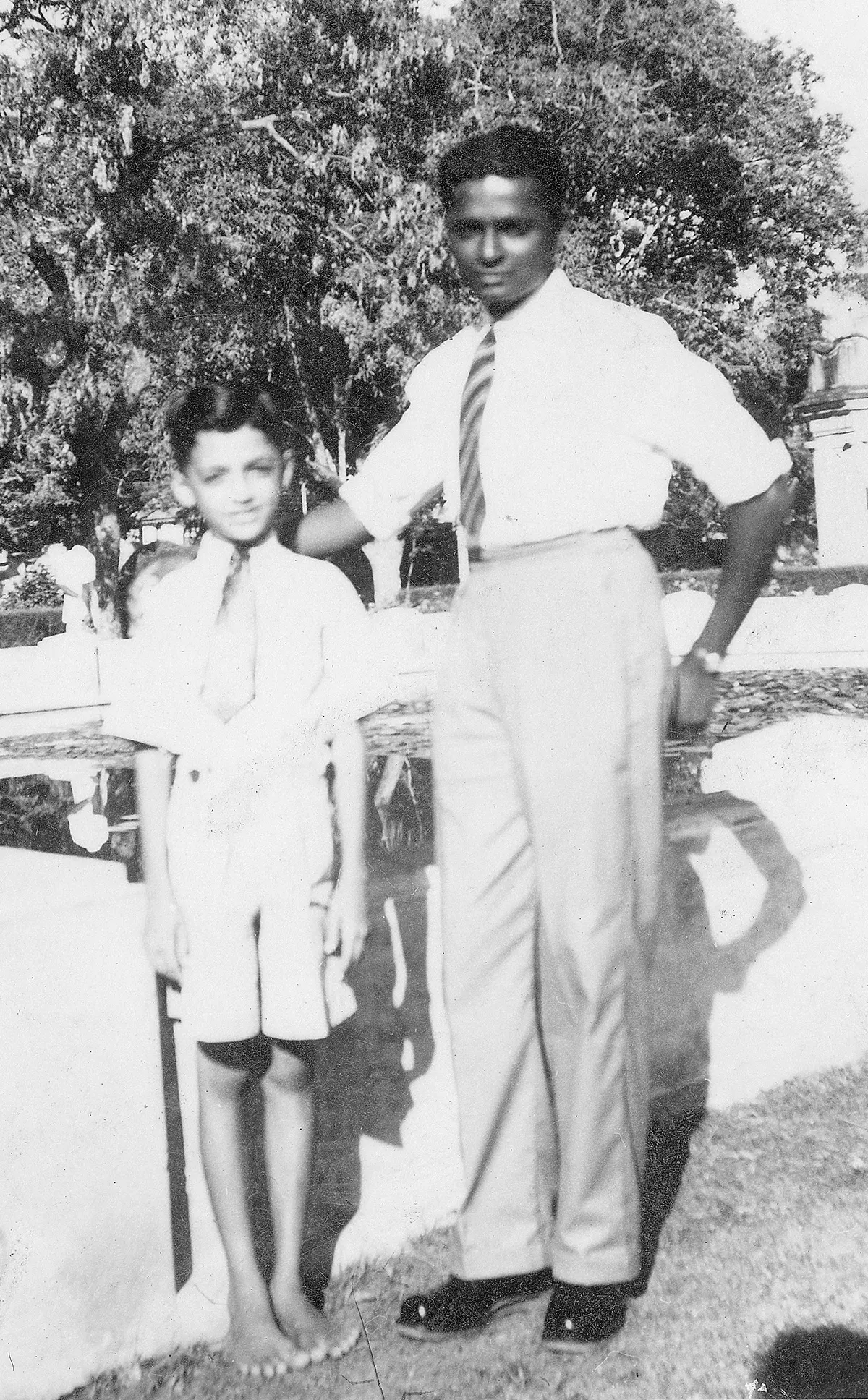
1951, at an Age of 7
Undergraduate and Postgraduate educations
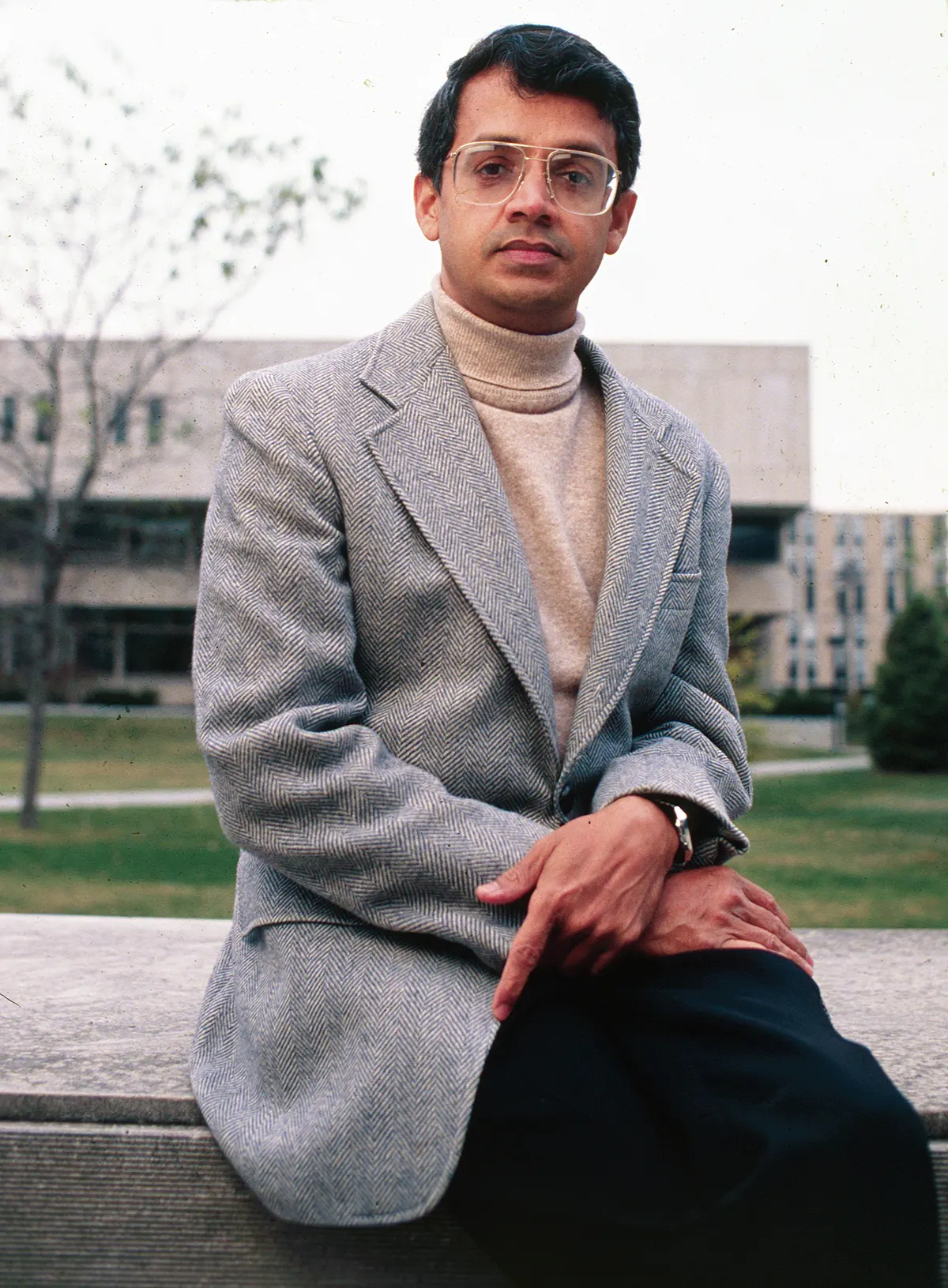
A Photo Taken in 1970s
Professor Ramanathan graduated with a degree in engineering from Annamalai University in India in 1965 and worked for two years in a refrigeration company. His job was to ensure that all the compressor components in the sealed refrigeration units were fitted correctly, so that the refrigerant (CFC-11, now called chlorofluorocarbon) did not leak from the sealed unit. However, he never imagined how it would have a profound effect on his work ten years later. At that point he did not have the knowledge to understand why refrigerants leaked and did not find the job inspiring because he was only required to follow instructions from the parent company in the USA. He also did not have much confidence in himself to pursue a different career path, so he quit his job after a while and decided to pursue higher studies at the Indian Institute of Science in Bangalore. During his master's studies, Professor Ramanathan spent three years developing independently a high-precision optical instrument called Mach-Zehnder interferometer, which could accurately measure temperature fluctuations in turbulent fluids. This was the first interferometer solely made in India. Looking back, he now says it was an impossible project to do in India at that time. With this achievement he gained confidence and realized his strengths in conducting independent research and taking on projects that everybody thinks impossible.

His Dream Car
He then moved to the USA in 1970 to work on a new interferometer at the State University of New York at Stony Brook. At the time, his main ambition was to gain an engineering degree in the USA, get a job at General Motors and live a good life driving his dream car, a Chevrolet Impala. However, his advisor at the university, Professor Robert Cess, had lost interest in engineering at the time and had shifted his research focus to the atmospheres of Mars and Venus, leaving Professor Ramanathan to work on reconstructing the greenhouse effect on Mars and Venus. This was a study of the greenhouse effect of carbon dioxide since the primary gas in the atmospheres of Mars and Venus is carbon dioxide. It was a disaster of the worst kind for him, as his dreams of getting the Chevy Impala were dashed. He finished his PhD in planetary atmospheres, a completely different field than his original engineering major. He now credits Professor Cess for the luckiest career break in his life. Cess was also a remarkable advisor, who realized the strength of Ramanathan and let him do independent research. This turn of events paved the way for a new career path for him.
Groundbreaking Discovery and Opening Pandora’s Box
After completing his PhD, Professor Ramanathan went to work for NASA, where he was tasked with developing a climate model to study the impact of stratospheric ozone depletion on the Earth's climate. While working at NASA he read a paper by chemists Drs. Molina and Rowland, on the depletion of the ozone layer by chlorofluorocarbons (CFCs). His scientific curiosity and penchant for independent research led him to look into the greenhouse effect of CFCs, instead. Molina and Rowland's theory was that CFCs decompose in the stratosphere, causing the depletion of the ozone layer. Ramanathan's theory was that CFCs also can impact climate directly through their greenhouse effect, which is a problem of quantum mechanics and climate physics and had nothing to do with the Molina/Rowlands chemistry effect. He was drawn in part to CFCs because of how the leakage of CFCs from the sealed refrigeration unit had plagued him when he was working for the refrigeration equipment manufacturer eight years earlier.
Since his day time job at NASA was on a different topic, he carried out intensive research on CFCs and did all his calculations at home in the evening after returning from NASA. After a month into his research he realized that this could potentially be a huge issue. He would take his young wife Giri for walking after dinner and pour out his heart about his new theory. He tested his hypothesis repeatedly over three months and in 1975 he finally discovered that chlorofluorocarbons have a greenhouse effect 10,000 times more potent than carbon dioxide. It was 78 years after a Swedish scientist discovered that carbon dioxide had a major impact on the climate in 1897. This discovery that there are other substances than carbon dioxide which could have a huge effect on global warming opened up a new research field in science.
His ground-breaking discovery was a great help to his career and his family life. It brought an unknown scientist from India into the mainstream of climate and atmospheric science study, and opened the door for an immigrant researcher to conduct his own research. It also helped his married life, who may have been frustrated by him spending his days and nights just working on his research, that he actually has a potential to become a great researcher and she became involved in his career and protected his time from all family distractions. But there was something else that this discovery brought to light. It opened up a Pandora's box of greenhouse gases. In the years that followed, he and other researchers around the world discovered other trace greenhouse gases such as stratospheric and tropospheric ozone, carbon tetrachloride, methane and nitrous oxide. The study of trace gases has also contributed to the creation of a new field of study called Climate-Chemistry interactions, that brought in stratospheric ozone destruction, air pollution chemistry and climate change, all under one umbrella. Recognizing the importance of his CFCs discovery, NASA and the United Nations convened an international group of scientists in 1983 to review the science of non-CO2 greenhouse gases. They asked Ramanathan to chair this committee and under his leadership, the group released a NASA/UN report in 1985 which concluded that as of the 1980s, greenhouse gases other than carbon dioxide were contributing as much as carbon dioxide to global warming.
The Overview of Global Warming (Explanation from Prof. Ramanathan)
How does global warming work? How do gases like carbon dioxide, when released into the atmosphere, warm the entire planet from north pole to south pole?
Suppose you drive a car today to your work. Half of the carbon dioxide emitted from that car will remain in the air for about 100 years. During that time, the remaining carbon dioxide will be transported by winds all over the atmosphere of the planet such that it covers the entire planet like a blanket. That is how a local action like driving a car in your neighborhood becomes a global problem.
What happens next? To go to this next step, you need additional background on how the planet's climate is determined. The main energy source for the planet is sunlight. Sunlight heats the atmosphere, the surface of the earth and the oceans, and generates heat, which we refer to as infrared heat. Certain gases like carbon dioxide in the atmosphere trap this heat. This additional heat trapping warms the planet further. The trapping of infrared heat by the blanket of carbon dioxide and other gases is called the greenhouse effect. There is another simpler metaphor to explain this effect.
Think of the carbon dioxide enveloping the earth as a blanket covering you during a cold night. The wool blanket covering you is carbon dioxide and you are the planet. How does the blanket keeps you warm? By trapping the heat from your body and thus preventing the body heat from escaping to the colder room. Likewise, without the carbon dioxide, some of the infrared heat from the planet and the atmosphere would have escaped to the cold space outside the planet. It's the same thing. So when you cover yourself with a blanket, it prevents the release of heat and traps the heat. In the same way, nature provides us with natural blanket of carbon dioxide and other greenhouse gases like water vapor and ozone to keep the earth from getting too cold. This is how the planet creates a habitable climate in which we humans can live comfortably.
Without the naturally occurring greenhouse gases, the Earth would be too cold for us to live on. Greenhouse gases are a necessity. The problem is that we don't need too much of them. In its natural state, the Earth had a perfect balance of carbon dioxide, water vapor, ozone and clouds.
There was one fundamental issue about clouds that caught his attention for nearly 10 years during the 1980s. Clouds trap infrared heat and warm the planet. But at the same time, clouds reflect sunlight which would have otherwise reached the surface and heated the planet. Thus clouds have both a cooling and warming effect. Scientists then did not know what the net effect was. Climate models suggested that the cooling effect was much larger than the warming effect. Ramanathan teamed up with NASA scientists and designed a satellite experiment called the Earth Radiation Budget Experiment (ERBE). It was launched in 1984 and Ramanathan with the NASA team used the data to show in 1989, from ERBE observations for the first time, that the cooling effect of clouds was almost twice as large as the warming effect, thus placing clouds as the most important regulator as well as a climate feedback component of climate change. The same year in 1989, he published another landmark study to show the dominant natural greenhouse effect of water vapor and its potential to double the sensitivity of climate to increase in other greenhouse gases, through the water vapor-climate feedback.
In summary, the Earth emits infrared heat into space to prevent too much heat from being trapped. However, humans continue to emit greenhouse gases and air pollutants that are trapping infrared heat that should be escaping. So this is how global warming works. We need to reduce both air pollutants and remove excessive greenhouse gases as soon as possible.
A Large Project and Atmospheric Brown Clouds (ABC)
Through new research studies and discoveries, people began to realize that the global warming issue requires greater and urgent attention. Prof. Ramanathan joined the National Center for Atmospheric Research (NCAR) in 1976 and began his research with meteorologist Roland Madden to predict when the trend of global warming would occur. In 1980, they published the first such study which predicted that, if the greenhouse effect theory was reliable, global warming would begin to show signs by the year 2000. Unfortunately, their prediction came true. It was in 2001, a team of international scientists assembled by the United Nations concluded global warming has been detected. A remarkable prediction of a complex system. However, the observed global warming was lower than those predicted by the professors.
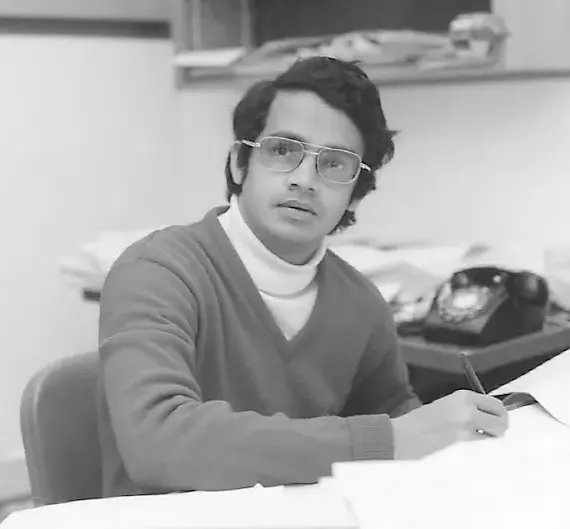
1978, Age 34
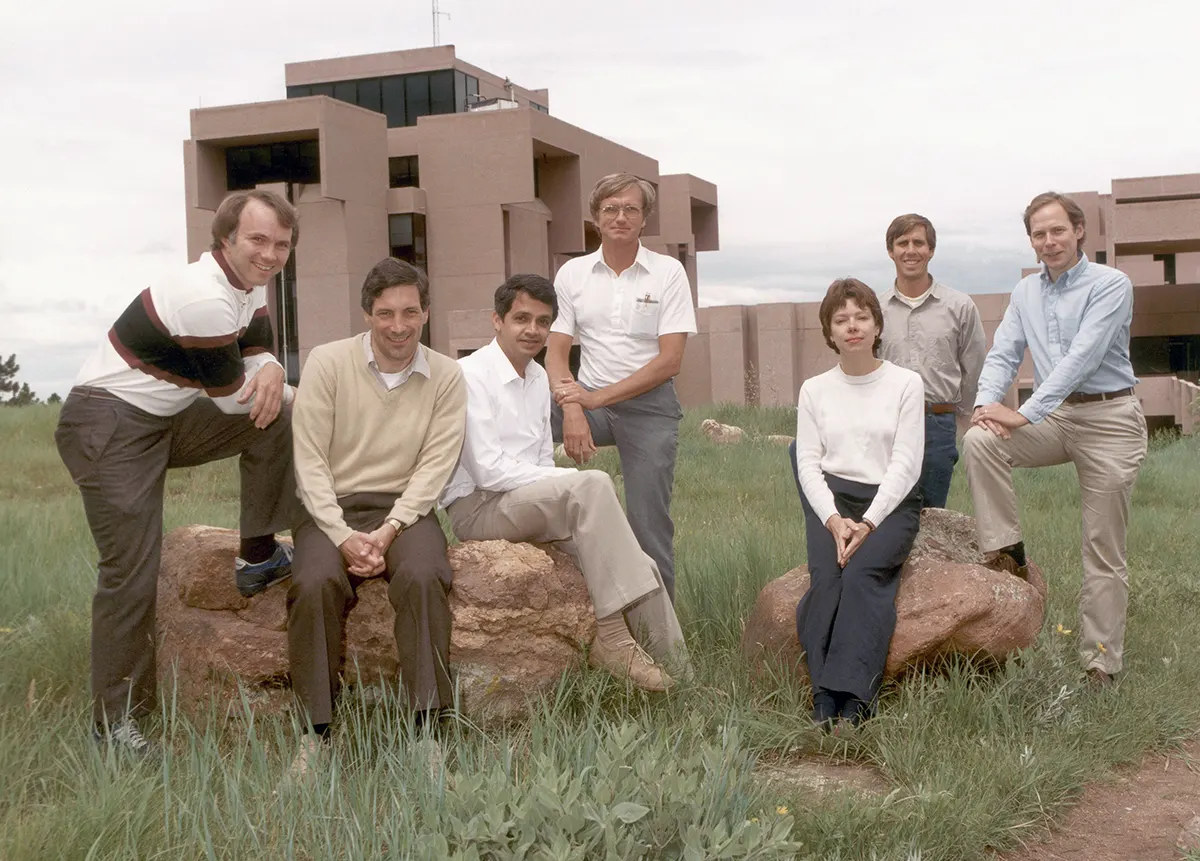
1981, Age 37 (middle) with NCAR Researchers
Scientists wondered why the warming was lower than predicted and suspected that the warming has been partially offset by a cooling effect caused by certain particles in the air, or air pollution, also from fossil fuels. This is where Professor Ramanathan's credo comes into play. He is a man who has to prove everything out for himself. In 1995, together with Dr. Paul Crutzen (Nobel Laureate in Chemistry) and Dr Mitra from India, he devised a large-scale international experiment, the Indian Ocean Experiment, to observe the cooling effect. This major experiment took place in 1998-1999, involved more than 200 scientists from six countries, satellite data collection, and observations by six aircraft and two ships. The experiment observed a three-kilometer-thick cloud of air pollution, the so-called Atmospheric Brown Cloud, covering much of the Arabian Sea, the Bay of Bengal and the Indian subcontinent, and found that it was blocking 10 to 15 percent of sunlight. The air pollution blocking the sunlight was largely made of tiny particles called aerosols. The experiment also identified that the aerosols blocking sunlight in the brown clouds fall under two categories: The first category of particles are sulfate and nitrate aerosols, which act like mirrors and reflect sunlight back to space and cause global cooling. The second category consists of black carbon particles, which trap sunlight and warms the planet. Black carbon is not a gas, but a particle. It is the black soot produced by burning coal, diesel engine fumes, or cooking food in stoves and cookers. It is also an air pollutant that kills up to three million people a year. Greenhouse gases trap heat and black carbon traps sunlight and both warm the planet. Sulfates and nitrates (emitted by fossil fuels) reflect sunlight and cool the planet. This cooling effect is referred to as masking effect, since the aerosol cooling offsets some of the warming from greenhouse gases and with strict air pollution regulations, the aerosols will be gone along with their cooling effect.
Both black carbon particles and sulfate/nitrate particles in Atmospheric Brown Clouds cause serious health problems to humans. Together these particles cause over 7 million premature deaths worldwide through diseases like asthma, lung cancer and cardio-vascular diseases.
In addition to the impacts on global climate change and health effects, Atmospheric Brown Clouds also have major regional climate effects. The blocking of sunlight by these particles reduce sunlight from reaching the oceans. The blocking of solar radiation from air pollution particles is called as global dimming. It is the sunlight reaching the water which provides the energy for water to evaporate from the oceans, glaciers, rivers and lakes which fall down as precipitation. When sunlight is blocked from reaching the ocean, the amount of sea water evaporation is reduced. Less water evaporation from the sea causes a reduction in rainfall on land, which leads to drought. Professor Ramanathan and his students used the data from the Indian Ocean Experiment to show that the reduction in evaporation caused by global dimming slowed the monsoon circulation that brings rain to the 1.3 billion people of South Asia.
These global, regional and health impacts caused by Atmospheric Brown Clouds are perhaps the most compelling reasons to regulate air pollution worldwide, says Professor Ramanathan. However, there are some political considerations that need to be taken into account when regulating and reducing air pollution. That is, it is not the responsibility of any one particular region or country. Studies have already shown that pollution from the US crosses the Atlantic and reaches Europe and pollution from East Asia crosses the Pacific to the US, and so on. We don't know who is polluting where because the air is circulating around the world. Every one of us is polluting all other countries surrounding our own, and so we are never going to solve this problem by pointing fingers at each other, says Ramanathan. He adds, just like COVID-19, air pollution emissions anywhere will have impact everywhere around the world over time.
Short-Lived Climate Pollutants (SLCP) and Climate and Clean Air Coalition (CACC)
After this experiment, he realized a common framework is needed to solve both the global warming problem and the air pollution problem. The scientific reason was that both had same or similar sources of emissions; both impacted global and regional climate and both impacted the health of people and health of the planet. The outcome of this realization was that climate mitigation efforts have to target emissions of carbon dioxide as well as pollutants other than carbon dioxide. The list of these other pollutants was large and one could not target all of them. He focused on four pollutants whose combined effect on global warming was almost as large as that of carbon dioxide and in addition had catastrophic effects on human health (over 7 million deaths each year) and food production (destroying over hundred million tons of crops). The four pollutants are: Methane, HFCs (hydrofluorocarbons), black carbon and lower atmosphere ozone The common feature of these four climate pollutants was that their life time in the atmosphere was much shorter than that of carbon dioxide; as a result, they will respond much more rapidly to mitigation actions. Of the four, methane, ozone and black carbon were also air pollutants.
Carbon dioxide, the main villain, has a lifespan of 100 to 1,000 years. Chlorofluorocarbons (CFCs) also have a very long lifespan of 50 to 100 years. But methane has a lifespan of 10 years, HCFs, which were developed to replace CFCs also have a lifespan of 10 years, ozone has a life span of months in the lower atmosphere and black carbon has a lifespan of only 10 days. What does this all mean? If all diesel vehicles in the world were fitted with filters today, the filters would remove the black carbon and no new black carbon would be released into the atmosphere from diesel vehicles. The black carbon that is in the air today would disappear in a matter of weeks, and there would be no environmental impact from it, including air pollution. This would also bend the curve of global warming quickly, less than 10 years. Black carbon is also released from other activities, such as burning coal or wood.
However, this example shows that if we can reduce emissions of short-lived methane, ozone, HCFs and black carbon, which are (per ton of these chemicals) more potent global warming inducers than carbon dioxide, we can significantly slow down the rate of global warming. Professor Ramanathan introduced the idea of Short-lived Climate Pollutants (SLCPs) and wrote several scientific papers, policy studies and editorials in newspapers with a number of researchers to show that reducing these pollutants would be highly effective in slowing global warming, and would also reduce crop and human health hazards in the atmosphere. In 2010, he was contacted by the United Nations to lead an international committee on short lived climate pollutants. He accepted, invited an independent scientist to lead the report and he served as vice-chair. This committee published a report which in 2012 founded the Climate and Clean Air Coalition (CCAC), which aims to reduce short-lived climate pollutants. The CCAC, with over 60 member countries and organizations, is the first UN initiative to focus specifically on short-lived climate pollutants. Initially launched with just six countries, the CCAC now includes more than 60 countries covering all regions of the world and supports a wide range of activities including policy, regulation and legislation, education and training, and funding to reduce short-lived climate pollutants. In November 2021, the reduction of SLCP emissions, which Professor Ramanathan had been advocating for years, was finally agreed upon at COP26.
On October 15, 2016, with the United States' leadership, 197 countries adopted an amendment to phase down HFCs under the Montreal Protocol in Kigali, Rwanda. Under the amendment, countries committed to cut the production and consumption of HFCs by more than 80 percent over the next 30 years. During COP 26 in 2021, US President, Joe Biden, announced a methane pledge along with over 100 nations to reduce methane emissions by more than 70% compared with their emissions during 2005 to 2012. Reductions in methane will also reduce ozone levels in the lower troposphere. In addition, 2021 President Biden's climate plan includes support to nations for reducing black carbon emissions from cooking by the poorest three billion in the world. The UN has also created a global cookstove alliance to promote clean cooking, which will eliminate the biggest source of black carbon emissions. The second biggest source of black carbon is diesel vehicles and with electrification of transportation under the carbon dioxide mitigation actions, this source of black carbon will also be eliminated. Thus, a lifelong quest and journey that began in 1975, is closer to the finish line.
Science and Religion
In 2004, Prof. Ramanathan became a member of the Pontifical Academy of Sciences in Rome. He was nominated by Dr. Paul Crutzen, who was already a member. As he participated in various conferences as a member of the Academy, he realized the potential of this ecclesiastical body to be a mediator of change on climate and environmental issues, and decided to organize a conference. Since both the Pontifical Academy of Sciences and the Academy of Social Sciences are a part of Holy See, he suggested that each of them organize a conference on the theme of "sustainability" and encouraged them to co-organize a conference. Eventually the theme from the Academy of Sciences was decided to be "Sustainable Nature", and the Academy of Social Sciences' theme be "Sustainable Humanity", with the addition of the words "Our Responsibility".
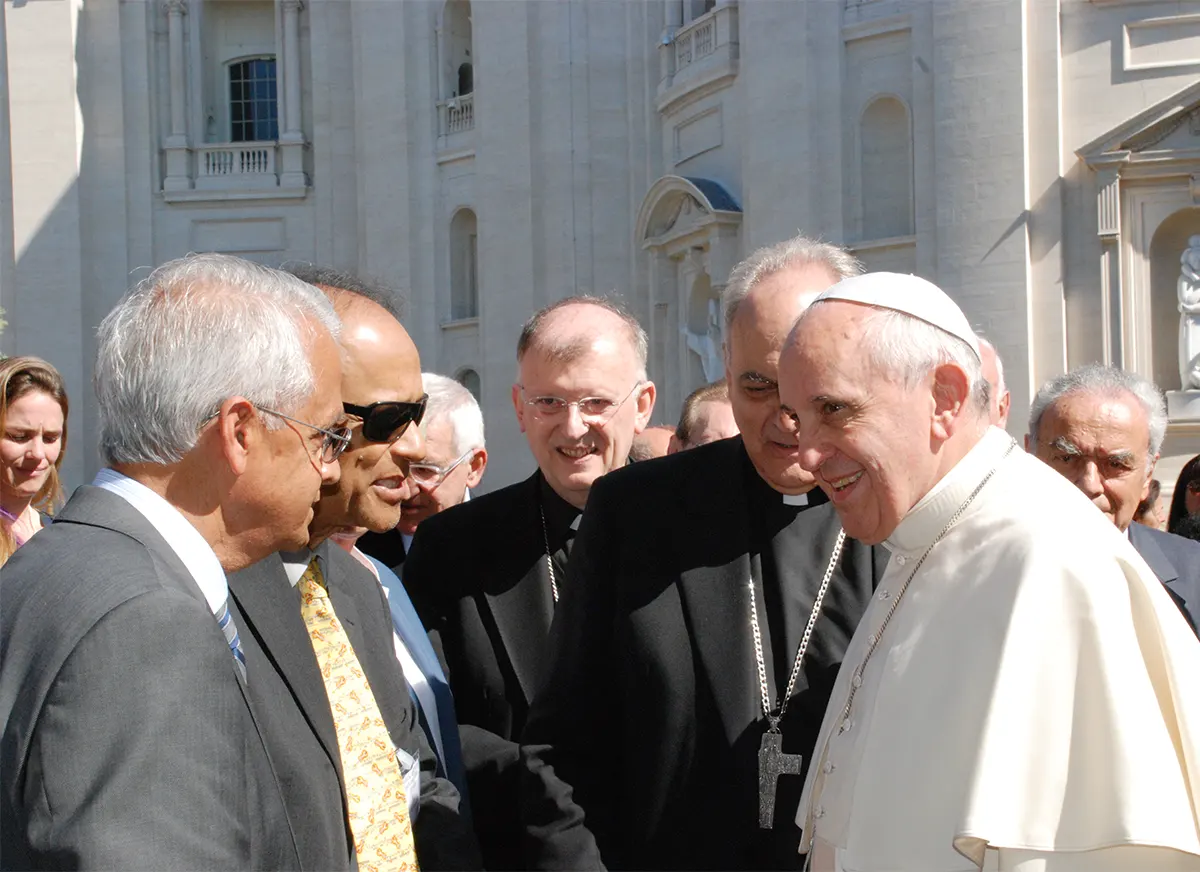
Pope Francis, the 266th Bishop of Rome
The proposal was reviewed by the Church and agreed to by the Pope, and the conference took place in May 2014, bringing together 30 leaders from different fields. A letter from Pope Francis was attached to the cover of the invitation. One of the landmarks of this conference was its commitment to "Our Responsibility." Until then, there was no scientific paper that contained the words "our responsibility". Prof. Ramanathan's intention was to "clarify who is responsible" for the climate problem caused by air pollution. He presented data to show that more than 50% of the greenhouse gas pollution comes from the top wealthy one billion people, while the poorest three billion people contribute 5% or less. He persuaded the assembled group that global warming is largely due to over-consumption by the wealthy. The meeting ended with the conclusion that "humanity must fundamentally change its attitude to each other and nature. "
When the Pope asked him what he could do to help, the professor replied: "you have now become a moral leader of the world, beyond Catholicism. So in your speeches, please ask people to be good stewards of the planet." Prof. Ramanathan has thus laid the foundations for science and religion to work together on climate change, and for climate change to be accepted also as a moral issue. There are areas where science and religion are in conflict, such as ideas about evolution and the genome, but the need to protect nature is something that all religions agree upon and teach. We can enjoy the gifts of nature, but should not abuse them. Moral values differ across generations so things may not be so straightforward, but religious leaders can teach moral lessons that scientists and politicians cannot, for humans to face thousands of years of adverse climate changes.
Prof. Ramanathan was also able to engage with the 14th Dalai Lama at a few events. The 14th Dalai Lama has said that compassion across borders is the way to solve the problem of climate change. And based on the professor's advice, he also mentioned global warming during his 2017 discourse at the University of California, San Diego. Prof. Ramanathan has also spoken to Hindu leaders and continues to be actively involved in forming alliances with faith communities for the fight against climate change.
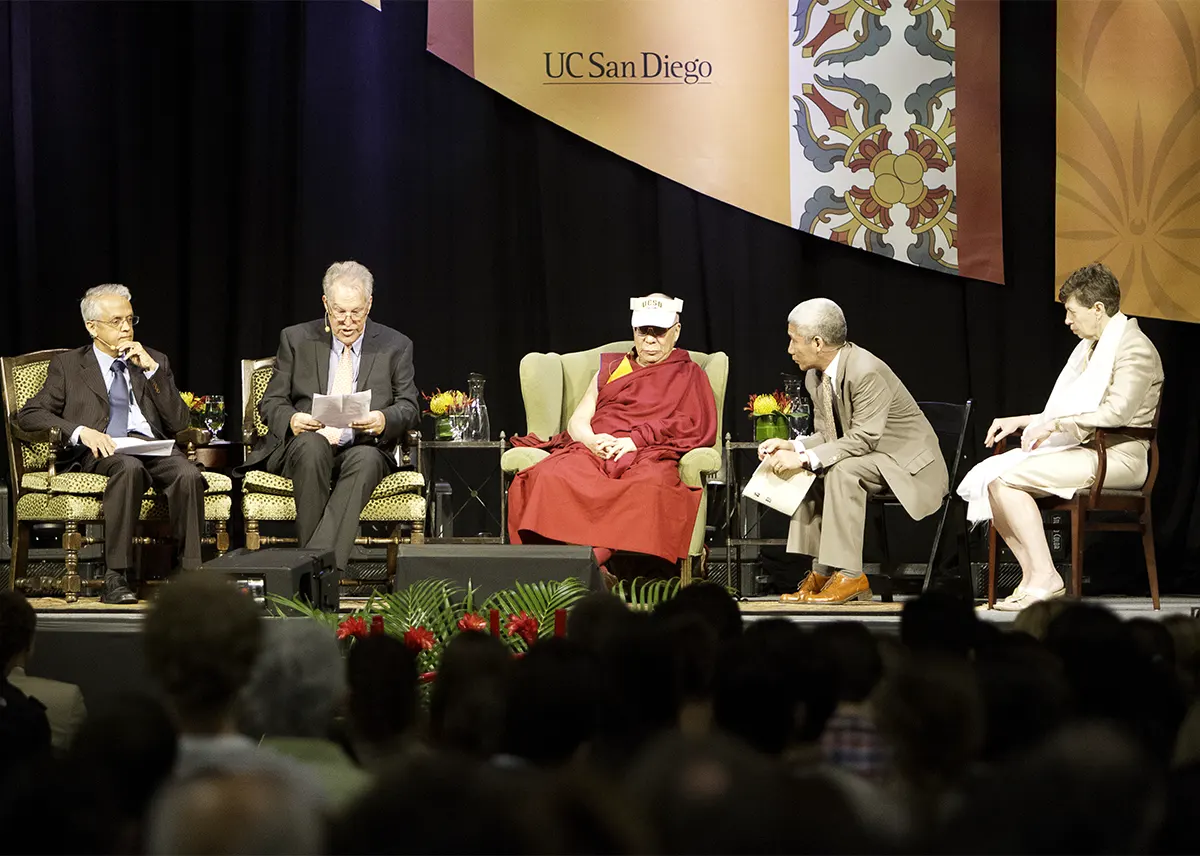
A Talk with the 14th Dalai Lama (2012)
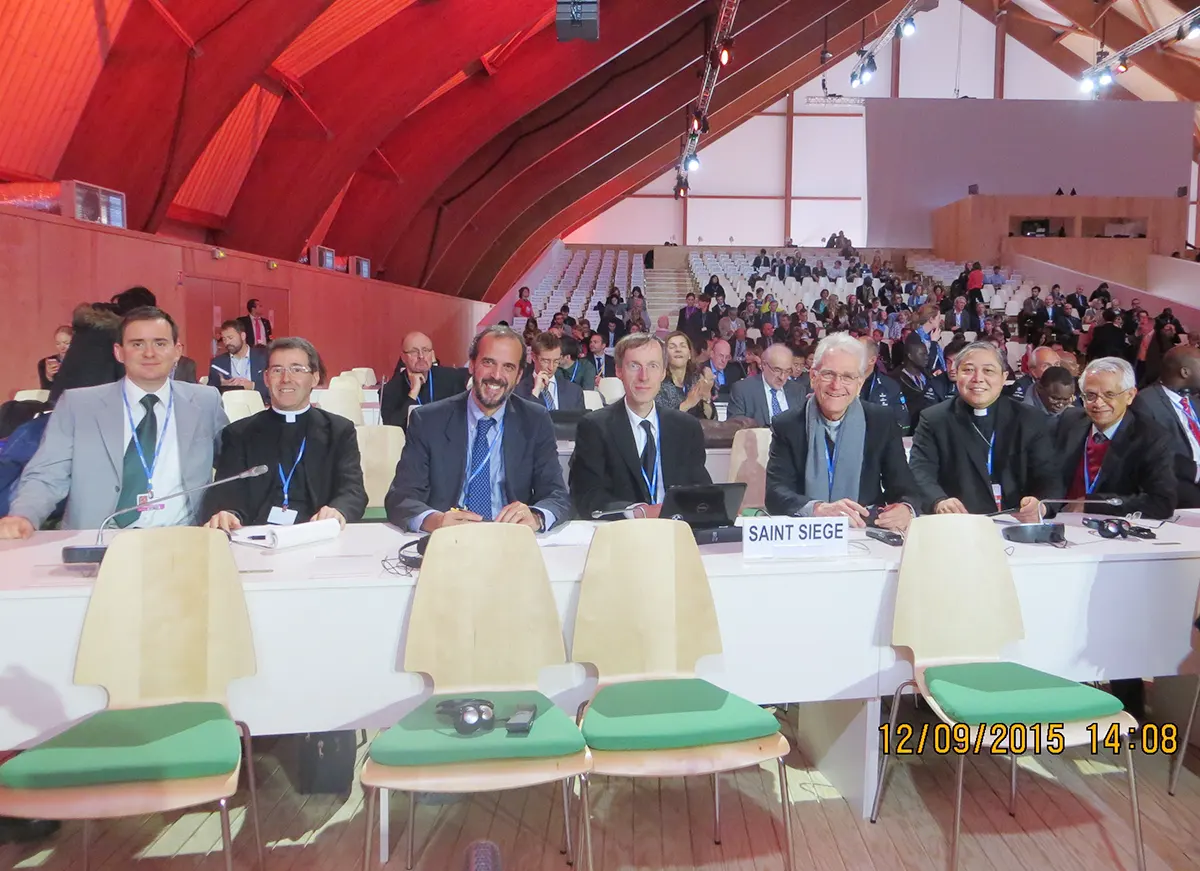
COP21 in Paris as Science Advisor to Pope Francis' Holy See Delegation (2015)
Evolved Creed
In 2004, Prof. Ramanathan turned 60 and decided to shift his focus more to climate actions. There were four reasons for this. Firstly, when he looked back at his previous works, he felt that, although he had produced a series of major research papers, he had in a way only brought a steady stream of damaging information about what was happening to the planet. The second was when he saw his hometown completely covered with big brown clouds during the Indian Ocean Experiment. The third was when he was invited to join the Pontifical Academy of Sciences to help solve environmental problems, and the fourth was when he told the story of the brown cloud over the Indian Ocean to high school students from all over the world at the UN General Assembly.
He was approached by a female Ethiopian student, who told him that she was moved to tears by his story, but then she asked, what he was doing about it. He was shocked when he couldn’t answer. In the midst of all these events, he began to feel strongly that it was no longer enough to pursue science, but we have to translate our research to actually solve the problem. So, together with his daughters, he started Surya project to provide a non-polluting cooking method in small villages in India. It was although a small first step towards a solution but indeed a life-changing experience for him.

Prof. Ramanathan at Surya Project
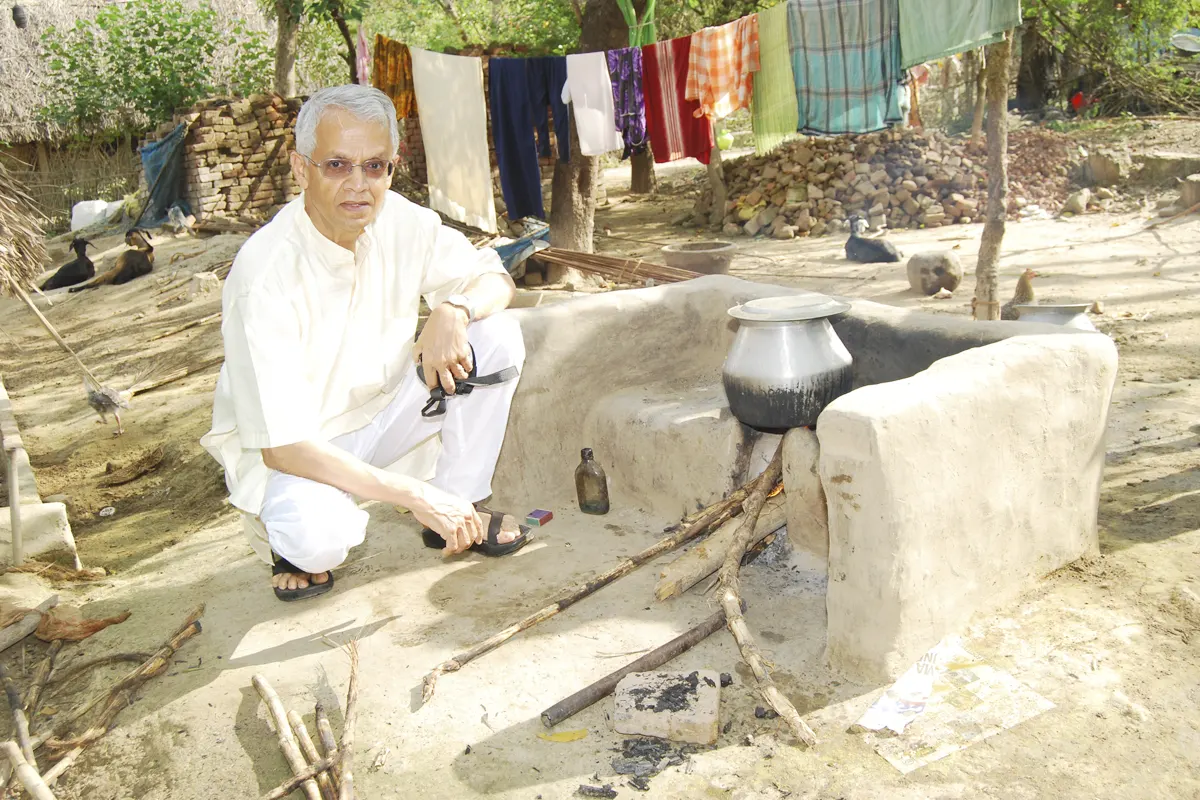
Surya Project

Family Portrait (2017)
Prof. Ramanathan seen from his wife, Giri
He and his wife, who will celebrate 50 years of marriage in 2023, are both from Chennai. They married in an arranged marriage. Ramanathan calls her his soul mate and credits his achievements for his wife's intellectual and family companionship and support. According to his wife, Prof. Ramanathan is a goal-oriented man who always puts his work first. However, he never neglected his family. Even though he was busy travelling around the world conducting research and experiments with people from all over the world, he always came home for his birthday, his wife's birthday and anniversaries. He also always made sure that they understand each other well by explaining to his wife about what kind of research he was doing, why he had to go on a business trip and why he was working at night, so that she would not have any worries or doubts.
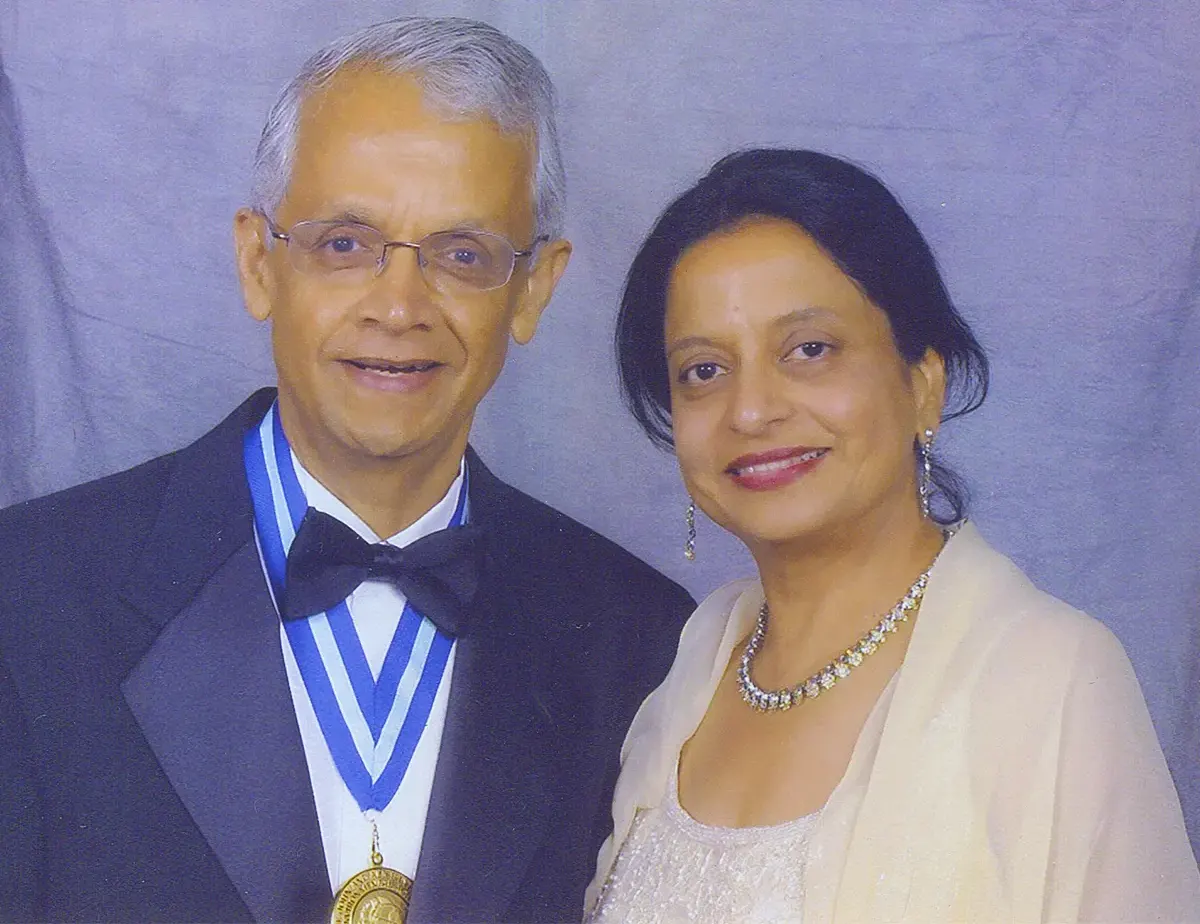
With His Wife, Giri
His wife says that she has never had any complaints about the professor, although she is an independent thinker, but she dedicated herself to her husband and children and now grandchildren. She says that Prof. Ramanathan is "a man who always tries and is never satisfied. No matter what prizes he wins or how many prestigious scientific journals he gets published in, it doesn't matter to him. His eyes are always on the goal and right now, he is driven by the need to make a difference by reducing the substances that are causing global warming, so that everyone does not suffer as a result."
What we need to do for future
There are still many people in the world who believe that humanity has nothing to do with the problem of climate change, and many also think that there is nothing we can or should do about it. The first thing we need to do is to feel responsible, says Prof. Ramanathan. If you realize that you are responsible for your own actions, you can change yourself. You can change yourself a little bit by being aware of the fact that the petrol car you drive can make people in Africa or India homeless, or that your actions can make your great-grandchildren homeless, because of drought caused by climate change. We can change ourselves little by little by being aware of our responsibility.
What can we do to slow down the pace of global warming? We all need to change our attitude to nature. There are three important things we can do. First, we must educate our children. Everyone needs to learn in all educational institutions that nature has a limit. It should be a part of the general education curriculum at all universities, so that students cannot graduate unless they have taken a course on the environment. He now leads a climate education program for all ten campuses of the university of California, called: Bending the Curve: Climate Solutions. The second is to form an alliance with religions for providing climate/environmental literacy to the general public. The third is for each individual to educate his or her friends, relatives, neighbors and colleagues about environmental issues. These actions will eventually lead to societal transformation. Societal transformation is the most important pillar for solutions to the climate crisis and is indeed Prof. Ramanathan’s most fervent wish.